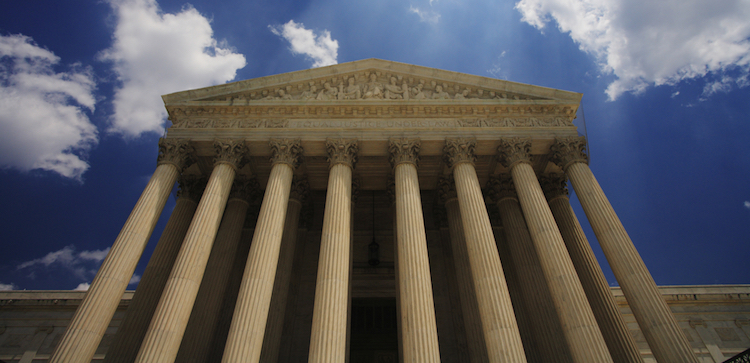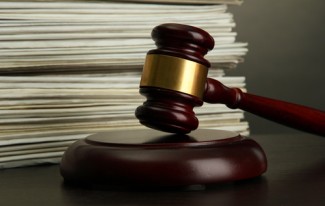The Supreme Court's 'shadow docket' is drawing increasing scrutiny

Image from Shutterstock.com.
The U.S. Supreme Court’s “shadow docket” is coming in from the dark. The term refers to emergency orders and summary decisions that are outside the high court’s main docket of argued cases and decisions.
University of Chicago law professor William Baude is credited with coining the term “shadow docket” in a 2015 law review article, though the specialized docket has been around for decades.
“It’s always been a thing and it’s always been important, but it was something that only elite Supreme Court practitioners paid attention to,” Baude tells the ABA Journal.
The shadow docket has attracted growing scrutiny recently as President Donald Trump’s administration has repeatedly filed applications with the high court seeking emergency relief on a range of matters. The trend intensified during this past term. Meanwhile, the coronavirus pandemic, election issues and other matters have prompted a steady flow of emergency applications to the court.
And the fact that the shadow docket has stayed busy after the justices issued their last opinions for the term in argued cases in July (a little later than usual because of the pandemic) has only added to the scrutiny.
“Narratives about the Supreme Court and its regular docket are increasingly incomplete,” says Stephen I. Vladeck, a law professor at the University of Texas at Austin, who has also written about the shadow docket.
This specialized docket has become increasingly important in three ways, Vladeck says. First, there are many more significant rulings coming out of the shadow docket than in even the recent past, he says.
“Some of that is by fortuity and some by design,” he says.
Second, the federal government has been especially aggressive in taking advantage of the shadow docket, often bypassing federal appeals courts to ask the high court to block or undo federal district court actions, Vladeck says.
And third, the court’s conservative and liberal blocs have split sharply, and sometimes bitterly, in this specialized area, he says. The court had decided 11 shadow docket matters by a 5-4 vote this term as of Aug. 11, almost equaling the dozen 5-4 decisions among the 53 decisions stemming from argued cases this term. (The counter is still running on the shadow docket because the 2019-20 term runs until the new term begins in October.)
“The shadow docket looks to be a heck of a lot more polarized than the more visible work of the court,” Vladeck says.
Hot-button categories
Whether they were decided 5-4 or by some other lineup, shadow docket actions this term mostly fell into three prominent categories.
COVID-19: The court in May denied a request from a California church for relief from the California governor’s orders limiting attendance at places of worship because of the coronavirus pandemic. And in July, Chief Justice John G. Roberts Jr. joined with the court’s liberal bloc to turn away a Nevada church’s similar request for relief from state attendance limits. Justice Samuel A. Alito Jr., in a dissent in the Nevada case, said the court was joining with the state in discriminating in favor of the powerful gaming industry.
“The Constitution guarantees the free exercise of religion,” Alito wrote in Cavalry Chapel Dayton Valley v. Sisolak. “It says nothing about the freedom to play craps or blackjack, to feed tokens into a slot machine, or to engage in any other game of chance.”
Election issues: Several emergency applications this term have involved election matters, with a subset of those stemming from COVID-19 concerns. The court sided with state officials on several issues, such as blocking pandemic-motivated lower court orders that had expanded procedures for gathering signatures for ballot initiatives in Idaho and Oregon while allowing Rhode Island to suspend its requirement that absentee ballots have in-person witness verification.
In April, the court stayed a lower court injunction that would have required Wisconsin to count absentee ballots postmarked after the state’s primary election date. The majority in an unsigned opinion said it was not expressing an opinion on the broader question of whether election procedures should be altered in light of COVID-19. Justice Ruth Bader Ginsburg, writing in dissent for the court’s liberal bloc, said the majority’s “suggestion that the current situation is not ‘substantially different’ from ‘an ordinary election’ boggles the mind.”

Image from Shutterstock.com.
Trump administration policies: Two rulings granted the Trump administration’s requests to lift injunctions blocking new rules that tightened the admissibility of immigrants who might become a “public charge,” or dependent on welfare or other public benefits. Another ruling turned away a request from opponents of the president’s border wall to order a temporary stop to construction. And the court granted the administration’s requests to remove lower-court stays blocking the first three federal executions in a generation.
In February, in one of the cases about the public charge rule, Justice Sonia Sotomayor expressed frustration, as she had in the previous term, about the Trump administration’s shadow docket tactics.
She wrote in a dissent to the court’s granting of an emergency stay in Wolf v. Cook County that there was “a now-familiar pattern” in which the administration “seeks emergency relief from this court, asking it to grant a stay where two lower courts have not. The government insists—even though review in a court of appeals is imminent—that it will suffer irreparable harm if this court does not grant a stay. And the court yields.”
Sotomayor said the Supreme Court itself was “partly to blame” for the breakdown in the appellate process.
“Stay applications force the court to consider important statutory and constitutional questions that have not been ventilated fully in the lower courts, on abbreviated timetables and without oral argument,” she wrote. “They upend the normal appellate process, putting a thumb on the scale in favor of the party that won a stay.”
And “perhaps most troublingly, the court’s recent behavior on stay applications has benefited one litigant over all others,” Sotomayor said, referring to the federal government.
Danger of ‘irreparable harm’
“Sotomayor has been sounding the alarm” about the administration’s approach, says Vladeck.
Since Trump took office, the Supreme Court had granted 22 stay requests as of mid-August, in whole or in part, from the federal government. In the 16 combined years of the President George W. Bush and President Barack Obama administrations, the court granted only four such emergency requests from the federal government.
Baude, a former law clerk to Roberts, says the Trump administration has been “unusually aggressive” in seeking emergency action on the shadow docket.
“It’s been successful for them so they’ll probably keep doing it,” he says.
The U.S. solicitor general’s office has argued among other things in most of these emergency applications that the federal government would likely “suffer irreparable harm” if the Supreme Court declined to grant the stay. Some of the Trump administration’s efforts sought high court relief from so-called nationwide injunctions, when a federal district court blocks a challenged federal law or program not just in its jurisdiction but across the country.
“When a district court imposes a nationwide injunction on a significant executive branch initiative, the Justice Department has little choice but to seek emergency relief from the court of appeals and/or the U.S. Supreme Court,” then-U.S. Solicitor General Noel J. Francisco said in a speech last year. (Francisco recently left the job to return to private practice.)
Even before Trump took office, Baude and others were starting to express concerns about the shadow docket. Baude argued in his 2015 law review article that there is a lack of transparency with the court’s summary reversals and emergency stays and that “the court’s non-merits orders do not always live up to the high standards of procedural regularity set by its merits cases.”
Summary reversals occur when the justices reverse a final lower court judgment without hearing arguments, usually because a majority believes the lower court ruled incorrectly on a well-settled issue. They are usually accompanied by an unsigned “per curiam” opinion by the high court. But emergency stays are less transparent, usually only offering some procedural guidance indicating the stay will last until the court a petition for a writ of certiorari is filed (and longer if the court grants review of the underlying case).
Baude calls for more openness on votes and perhaps even the reasoning behind its emergency orders. Only when four justices dissent on a stay, for example, does the public know that the vote was 5-4. On some emergency actions, there may be one or two recorded votes of dissent, but that does not mean all the other justices voted for the action.
Leah Litman, an assistant professor at the University of Michigan Law School, says she well remembers from her term as a law clerk to Justice Anthony M. Kennedy how much time and energy shadow docket matters consumed for the justices and the clerks. And that was in the 2011-12 term, well before the explosion of that docket.
“It’s a significant part of the job,” she says. The public understands little about how the court handles the shadow docket because those matters aren’t argued, the decisions aren’t signed, and the majority’s reasoning is rarely offered.
“When the court isn’t explaining itself, a lot is left to supposition,” Litman says, adding that “any reform would have to come from the court itself.”
See also:
ABAJournal.com: “Another ‘shadow docket’ decision? SCOTUS once again blocks relaxed election procedures”



